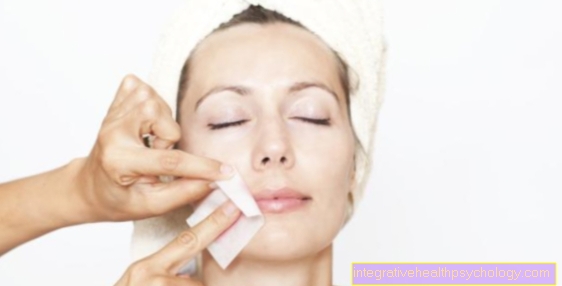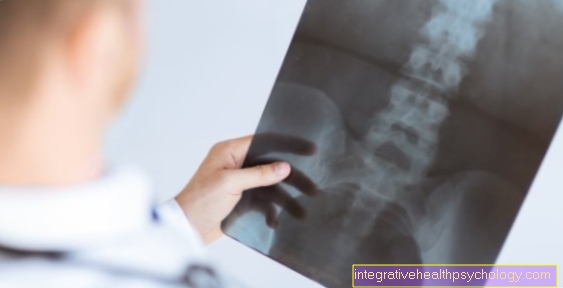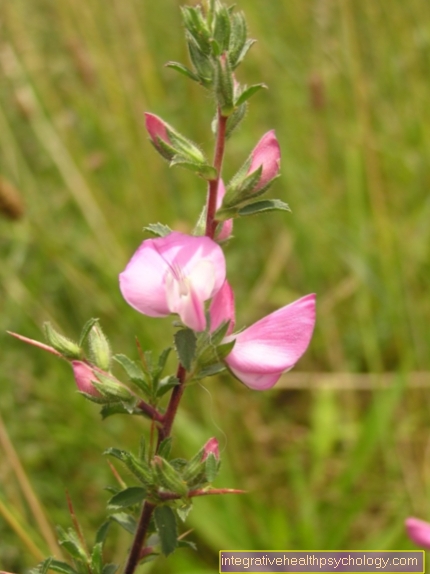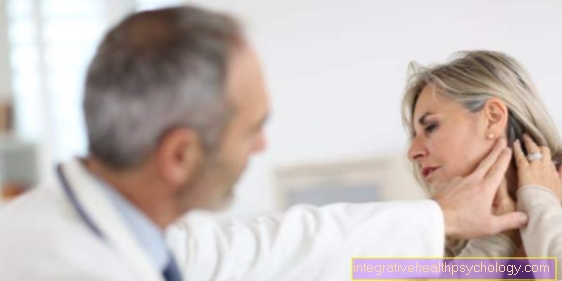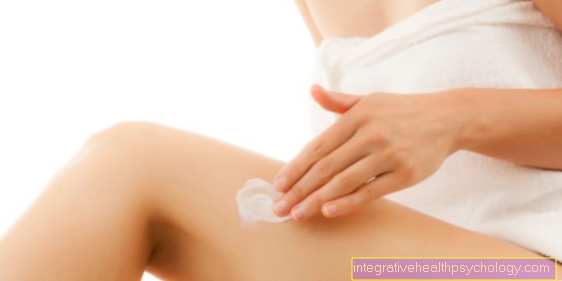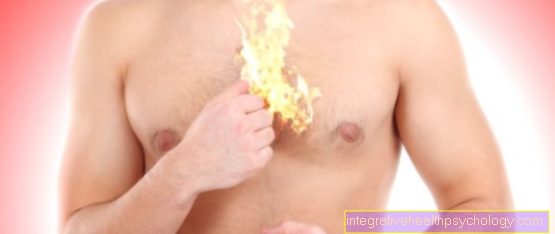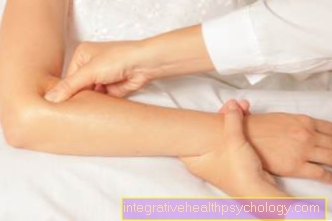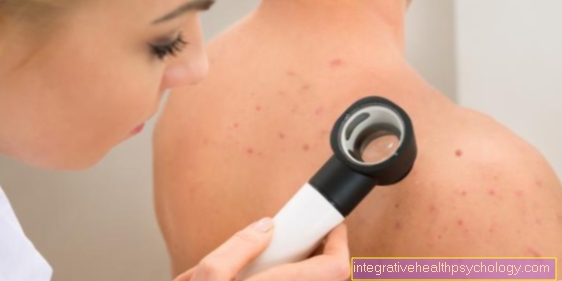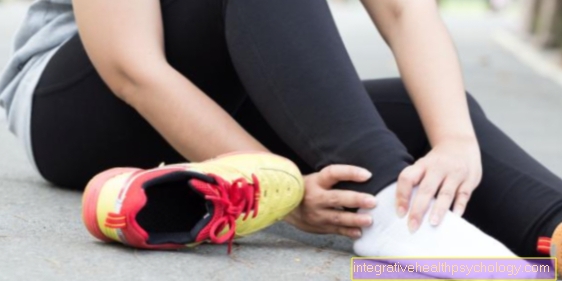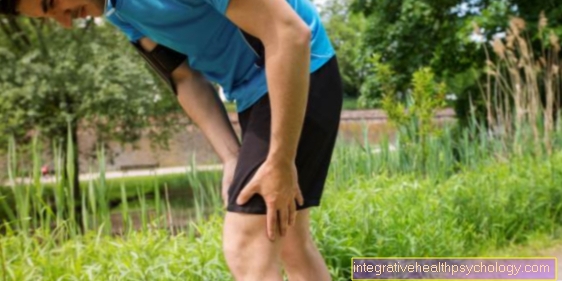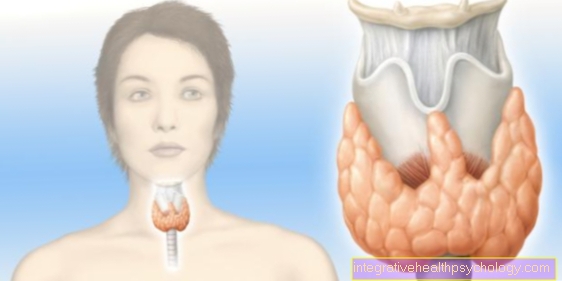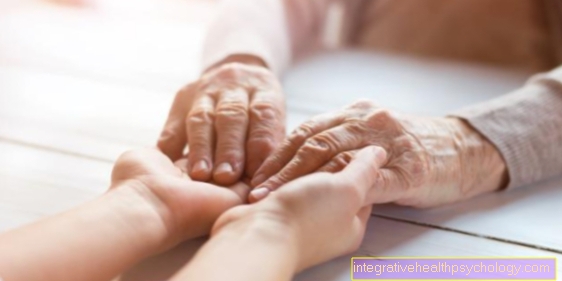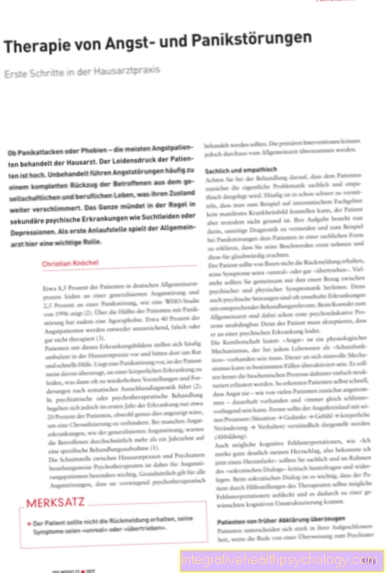psoriasis
definition
The name "psoriasis" is based on the Greek word "psora", which stands for "scratching" or "itching".
Psoriasis is a benign, chronic, non-infectious, inflammatory skin disease. It is characterized by well-defined, reddish spots that are usually covered by whitish scales. A distinction is made between two forms (psoriasis vulgaris and psoriasis pustulosa), in each of which polyarthritis (inflammation of several joints) can occur.
Psoriasis is a skin disease that seems to have a hereditary component, as it often affects several family members.

Occurrence in the population (epidemiology)
Psoriasis occurs in 1.5-3% of the fair-skinned population and much less often in other ethnic groups.
Neither sex is affected more often than the other. So there is a balanced relationship.
The age distribution does not follow any regularity either.
Psoriasis occurs in both young and elderly people.
However, there are two peaks in disease: one is in the 2nd - 3rd, the other in the 6th decade of life.
Forms of psoriasis
Psoriasis can be divided into three different forms:
- Psoriasis vulgaris (general)
- Pustular psoriasis (pustular)
- Nail psoriasis
Therapy of psoriasis

Therapy for psoriasis always depends on the individual course and the severity of the symptoms.
At intervals when the psoriasis is not very developed, one should pay attention to good skin care that maintains the protective function of the skin.
Various high-fat creams are available here, some with special antiseptic ingredients. Baths with moisturizing bath additives also help with therapy if you don't bathe too warmly or too long.
Two ointment additives have shown that they have a positive effect on psoriasis: urea and Salicylic acid. They reduce flaking and support the skin in maintaining the natural protective barrier.
If the symptoms break out in the course of a psoriasis flare-up, a step-by-step treatment scheme is used in the clinic. A distinction is made here between mild, moderate and severe complaints.
First of all, ointments containing glucocorticoid (cortisone) are available, which form the basis of therapy in mild cases. They have anti-inflammatory and anti-allergic effects by inhibiting the growth of immune cells that have fallen out of line. In addition, the number of cells that cause or form the scales is reduced (Keratinocytes).
In addition, ointments containing substances similar to vitamin D3 are applied to the affected areas for therapy. As a result, other immune cells are restricted in their function.
Other substances used in the therapy of mild psoriasis are so-called retinoids and cignolin. New remedies include calcineurin inhibitors, which are also said to downregulate the immune system locally.
If these funds are not sufficient, further measures are added to the therapy for moderate psoriasis. Phototherapy, in which UV-A radiation or UV-B radiation is used, plays a major role here. These have a proven positive effect on psoriasis and are combined with ointments or baths.
As the last escalation stage in the therapy of psoriasis, funds are available that are also used in other medical fields to suppress the immune system. Some of them have very strong effects and also side effects. They are systemic, tablets or short infusions used. Ciclosporin or methotrexate (MTX) have been used for a long time.
New additions are antibodies that specifically block only one target and thus greatly reduce side effects.
What is exactly right differs from patient to patient.
Further information can be found here: Infliximab
Some patients report that their symptoms are alleviated by homeopathic remedies or acupuncture, for example. However, there is insufficient evidence that the effects go beyond a placebo effect.
Read more about:
- Treatment against psoriasis
- Psoriasis therapy
- Fumaderm
- Psoriasis in Pregnancy
light therapy
Laser therapy: Thanks to a very precise and thin laser beam, laser therapy offers the possibility of treating the affected skin areas very precisely. As a result, the surrounding tissue is hardly affected. The dose is adjusted depending on the severity of the disease.
PUVA: PUVA (psoralen + UVA) is a special procedure that uses the effects of substances that increase the skin's sensitivity to light. These substances are called psoralens. You can take them as tablets, but also apply, for example, as a cream. This increases the effect of UVA rays on the skin. It is believed that the overactive cells of the immune system, the so-called T cells, which are responsible for psoriasis, are inactivated by the psoralens.
Other light therapies: Other methods that use UVB and UVA radiation are narrow-spectrum ultraviolet radiation and selective ultraviolet phototherapy. Both procedures use radiation to the skin.
Read more on the topic: Light therapy for psoriasis
Psychological approaches
Under stress and great psychological stress, the patient's symptoms often worsen. Therefore, reducing these factors can lead to an improvement in the suffering. For example, there is the possibility Support groups visit or interview a psychologist on the subject. Psychotherapists and psychologists can help you deal with stress as well charges schools.
Electrotherapy: Electrotherapy is still a right new Procedure in which the affected skin areas are treated with a very low dose Interference current be treated. For this purpose electrodes are attached.The treatment is carried out twice a day for several weeks. Only then can you see results. The patient can also carry out the therapy himself with borrowed or purchased equipment.
Diet in psoriasis
There seems to be a link between celiac disease and psoriasis, so avoiding foods containing gluten can help ease the symptoms.
The emergence of psoriasis

Psoriasis is based on the benign proliferation of the epidermis. The skin cells migrate through the individual skin layers much faster than normal.
In healthy skin, the skin cells develop deeply from cell division of so-called stem cells and migrate into the upper layers as part of growth.
The normal migration time is around 28 days to get from the bottom layer to the top layer, the horny layer.
In psoriasis, the cells only need about 4 days.
The multiplication of skin cells is increased by about 20 times or more. This hasty and disturbed keratinization manifests itself in stronger keratinization and a widening of the epidermis. Inflammation develops in the skin and more blood vessels grow into it.
Also read the following article: Atopic Dermatitis And Psoriasis - What's the Difference?
Causes of Psoriasis
Psoriasis (psoriasis) is a disease that has a hereditary disposition. The predisposition to this lies in our genes. Thus, there is also an increase within families.
The theory of heredity was proven by means of twin studies. The increased occurrence in identical twins clearly speaks for the genetic component of psoriasis.
However, inheritance cannot be tied to a single gene, but is inherited on several genes (polygenic inheritance). Several external factors (e.g. environmental factors) also play a role (multifactorial inheritance).
It is believed that there is something called a threshold. So a certain limit has to be exceeded in order for the disease to break out.
It is assumed that psoriasis does not occur below this virtual threshold value.
It has also been observed that those affected have the antigen HLA-1 and HLA-2, a typical genetic code (genetic fingerprint).
Certain environmental factors can cause and promote the manifestation (becoming recognizable) of the disease in genetically predisposed people. These include:
- Infections (e.g. streptococcal infection)
- Medicines (e.g. beta blockers, anti-inflammatory drugs)
- Psychological stress
- alcoholism
- increased nicotine consumption
- Discontinue cortisone therapy
The experts also relatively agree that an immunological overreaction is the trigger for psoriasis. This immune reaction is mediated by defense cells called T lymphocytes.
Normally, the T lymphocytes are directed against foreign material, e.g. Bacteria and viruses. In psoriasis (psoriasis) the immune system can no longer differentiate between the body's own and foreign components and thus causes the disease itself.
Summer, climatic factors (sun and sea) and hormonal factors (pregnancy) have a positive influence on this disease.
The symptoms of psoriasis

Psoriasis vulgaris is the most common form of psoriasis and is characterized by its beginning as a punctiform focus that enlarges. The convergence of individual flocks creates different shapes. For example, a map-like shape, one with a more ring-shaped appearance and a shape that is sinuous.
It is a chronic autoimmune disease that progresses in relapses. It can appear almost anywhere on the body, but is often found in typical places. These include:
- Scalp (Please also read: Psoriasis of the scalp)
- Extensor sides of arms and legs
- belly button
- Anal fold
Genetic reasons are discussed as the cause, whereby infections, alcohol or stress can promote the occurrence of psoriasis vulgaris. External damage such as sunburn and chemical noxa also increase the risk of the disease. Psoriasis vulgaris rarely itches or hurts.
There are special forms:
- Geographical psoriasis
runs rather chronically and offers characteristic often mechanically stressed areas. The places where this form breaks out most often are the extensor sides of the arms and legs, elbows (see: Elbow rash), knees, fingers, the frontal hairline and the sacrum area. The spots (Plaques) are easy to define, usually reddish and covered with waxy scales. These plaques can vary in size, usually a few centimeters.
Read more on the subject at: Rash on the elbow - Guttate psoriasis
This type is more acute and is associated in more than 80% of cases with a previous infection with streptococci. The first appearance is before the age of 40. Adolescents are particularly affected; point- to lenticular papules and a symmetrical appearance are typical. The areas particularly affected are the torso, arms, and legs. For this type of psoriasis vulgaris, a rather severe course and psoriasis that has already occurred in the family are typical. - Inverse psoriasis
The distribution pattern is almost the opposite of the above. The body folds, the anal region, armpits and the bends of the joints are affected. The plaques are often red and shiny. The elderly are mainly affected. - Scalp
Here the cuticle layers are particularly thick. They occur individually, but also as an attack on the entire scalp. Hair loss often follows here. This special form can be the only form of psoriasis. - Diaper psoriasis
The rash occurs in the diaper area and is easy to define. From this a Psoriasis vulgaris develop.
Pustular psoriasis occurs in 5% of cases and has a pustular appearance. The pustules are filled with pus. Pustular psoriasis is divided into two forms.
- Generalized pustular psoriasis
This form is rare, but it is severe. It occurs all over the body and shows small, yellow pustules on a red background. It spreads quickly and the patient feels very uncomfortable, has a fever and needs to be hospitalized. - Palmoplantar pustular psoriasis
This form also shows yellow pustules, which, however, appear on the palms of the hands and feet. In contrast to generalized pustular psoriasis, the general condition of the patient is also good. Middle-aged women are mainly affected. There is an increased incidence among smokers.
Nail psoriasis occurs in 50% of patients. Pit and dimple nails are typical. Yellow-brownish spots appear in the middle of the nail bed (Oil stain), at the edge of the nail bed the nail loosens. With the so-called crumb nails, the growth of the entire nail is disturbed.
Read more about psoriasis on the page: Psoriasis on the face
Diagnosis of psoriasis
During the examination by the doctor, one of the scales will be carefully scraped off. The following psoriasis phenomena occur one after the other:
- "Candle drip phenomenon"
lamellar flaking emerges from the scratching - "Phenomenon of the last membrane"
A thin, easily tearable membrane can be seen at the base of the scale - "Phenomenon of the bloody dew"
further scratching leads to punctiform bleeding
Under the microscope you can z. E.g. the typical cornifications and inflammatory cells.
Course of psoriasis
Psoriasis lasts a lifetime with varying degrees of severity. It is not uncommon for the appearance to be impaired, which has psychosocial consequences.
The disease is difficult to cope with and problems arise in interpersonal relationships and, for example, in the workplace. Especially psoriasis that affects the face contributes to feeling unwell. (You also: Psoriasis on the face)
Psoriasis usually begins acutely generalized (suddenly and everywhere) or primarily chronic (slowly and with individual foci).
But mixed forms also occur and are quite common.
The psoriasis usually progresses in bouts, but there are rarely completely symptom-free intervals.
The manifestation (external signs) can be treated or reduced or even disappear completely. However, the disposition remains and cannot be cured. So the psoriasis will keep coming back.
Complications of psoriasis
The complications of psoriasis are:
- Arthropathic psoriasis
It affects about 5% of psoriasis patients. Inflammation of the distal joints occurs (joints that can be found at the extremities, e.g. toe joints, finger joints). This leads to swelling. Individual fingers can also be affected. Osteolytic (bone dissolving) forms are also known.
The axial type is much less common. This leads to a stiffening of the spine and the pelvic joints. - Psoriatic erythroderma
Too strong an external treatment leads to redness and flaking. This redness occurs all over the skin.
Psoriatic arthritis

Psoriatic arthritis is an inflammatory joint disease caused by antibodies raised against one's own body that has many similarities to rheumatoid arthritis.
The special thing about it is that psoriatic arthritis only occurs in some patients who suffer from psoriasis. The exact causes and processes that lead to the development of psoriatic arthritis are relatively poorly understood. However, a component causing a misdirected immune system is safe.
In order to develop psoriatic arthritis, the underlying disease psoriasis must be present. However, based on the severity of psoriasis, it is not possible to make a risk assessment of whether you will develop arthritis.
The leading symptom is diseases of the joints. Theoretically, all joints can be affected, but typically individual toe or finger end joints are inflamed, often all three joints of a single finger (involvement in the beam).
This distribution pattern is important because it allows psoriatic arthritis to be differentiated from the rheumatoid form. Characteristically, the basal joints of the fingers and toes are typically affected, but never the terminal joints. The skin over the joint is red and swollen, the patient complains of pain in the joint at rest and especially when moving. Most courses are limited to this, but in severe cases it can lead to joint destruction and misalignment of fingers or toes.
Large joints such as the knees, hips and spine are also relatively often inflamed as part of psoriatic arthritis.
In addition to the bony parts, ligaments and tendons are also affected, which is expressed in pain when moving.
The doctor diagnoses psoriatic arthritis based on the previous history (psoriasis) and the typical extent of the inflamed joints. An x-ray can reveal possible bone damage. A blood test for typical changes in rheumatism will rule out this diagnosis. At the end, a Fournié score is formed from all findings, in which the diagnosis is considered confirmed from 11 points.
The therapy for psoriatic arthritis depends on the severity of the symptoms. Cortisone treatments are possible. Sulfasalazine can be given in the case of mild infestation, and methotrexate in severe cases. New substances such as infliximab or etanercept, which have a more targeted effect, are being tested.
prophylaxis
There is no prophylaxis to prevent this disease from breaking out for the first time. However, certain risk factors, such as smoking and Obesity be avoided.
Thrusts can be delayed by following a healthy lifestyle. Smoking and alcohol should be avoided. Diet-specific show so-called Omega-3 fatty acids a positive effect.
These fatty acids are mostly in fish contain. Also beta carotene, which is mainly found in Carrots appears to bring some improvement. Good skin care is important - even in symptom-free times and hygiene. Also Relaxation exercises how Progressive Muscle Relaxation can delay the outbreak of a flare-up.
Individual handling of the disease can also have an impact.
On the history of psoriasis
The first descriptions of psoriasis can be found among the ancient Greeks.
At that time, however, this disease was confused with contagious leprosy. The disease appears again and again in the course of history. It was first described as an independent skin disease, however, only in 1841 by an Austrian dermatologist (doctor for dermatology). For the first time, he clearly differentiated psoriasis from leprosy.




.jpg)




